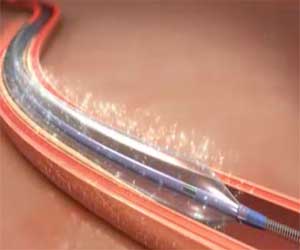- Home
- Editorial
- News
- Practice Guidelines
- Anesthesiology Guidelines
- Cancer Guidelines
- Cardiac Sciences Guidelines
- Critical Care Guidelines
- Dentistry Guidelines
- Dermatology Guidelines
- Diabetes and Endo Guidelines
- Diagnostics Guidelines
- ENT Guidelines
- Featured Practice Guidelines
- Gastroenterology Guidelines
- Geriatrics Guidelines
- Medicine Guidelines
- Nephrology Guidelines
- Neurosciences Guidelines
- Obs and Gynae Guidelines
- Ophthalmology Guidelines
- Orthopaedics Guidelines
- Paediatrics Guidelines
- Psychiatry Guidelines
- Pulmonology Guidelines
- Radiology Guidelines
- Surgery Guidelines
- Urology Guidelines
Drug Coated Balloons safer than Drug Eluting Stents for small vessel coronary artery disease, confirms a BASKET-SMALL 2 trial

Treatment of coronary artery disease in patients with small vessel coronary artery disease using Drug-Coated Balloons (DCB) may be a safer option than that of Drug-Eluting Stents (DES), revealed a study presented at the EuroPCR.
Although, Drug-eluting Stents are a default treatment option for patients with small vessel coronary artery disease it has limitations due to its adverse side-effects. In a BASKET-SMALL 2 trial, it was found that DCB is superior to DES for treatment of small vessel coronary artery disease concerning clinical events up to 12 months, with similar event rates for both treatment groups, but the angiographic data comparing both interventions are sparse.
The study presented at EuroPCR aimed at establishing angiographic data that will help to interpret recent findings of a major randomized controlled trial.
The authors did a prespecified analysis of a multicenter, randomized controlled non-inferiority trial. The main BASKET-SMALL 2 trial was conducted at 14 centers in Germany, Switzerland, and Austria in which 758 patients went for randomization and were included in the main analysis, out of which 367 patients received DCB and 371 patients received DES (93 received Paclitaxel ES, 256 received Everolimus ES and the remaining 22 received 2nd generation DES). Patients in the DCB group received dual antiplatelet therapy (DAPT) for 4 weeks, whereas those in the DES group received DAPT for 6 weeks if they did not have Acute Coronary Syndrom (ACS) or 1 year if they did have ACS.
The key findings of the study
- At 1 year, the rate of MACE was 7.33% in the DCB group and 7.45% in the DES group, a difference that met criteria for noninferiority
- It was observed that complete thrombotic vessel occlusion occurred in 8 patients with DES (Xience n=5, Taxus n=3) vs. none with DCB.
- The study looked at the clinically indicated angiography, which was performed in 64 patients in the DES group and 47 patients in the DCB group. At a mean follow up of 6 months, minimal lumen diameter in-stent and in-balloon was better with DES compared with DCB and diameter stenosis remained larger in the DCB group. Late lumen loss, however, was similar in both groups.
The authors concluded that complete thrombotic occlusion of the target lesion was observed in 8 patients after DES implantation as compared with none in DCB which verifies the safety of DS strategy in small vessel lesion patients.
The study was presented by Jeger R. Drug-coated balloons vs drug-eluting stents for the treatment of small coronary artery lesions: angiographic analysis from the randomized BASKET-SMALL 2 trial. Presented at: EuroPCR 2019. May 21, 2019. Paris, France.

Disclaimer: This site is primarily intended for healthcare professionals. Any content/information on this website does not replace the advice of medical and/or health professionals and should not be construed as medical/diagnostic advice/endorsement or prescription. Use of this site is subject to our terms of use, privacy policy, advertisement policy. © 2020 Minerva Medical Treatment Pvt Ltd